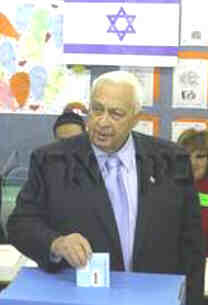 On
a January 28:
On
a January 28: 2003 (Tuesday) National elections in Israel (workers have the day off) for the 120-seat 16th Knesset Likud obtains 38 seats (it had 19 before), Labor-Meimad 19 (it had 26), in the lowest voter turnout (68.5% of the 4'720'074 registered) in the history of modern Israel. [Criminal Prime Minister Ariel Sharon, head of Likud, casts his vote >] The secularist Shinui Party, let by Yugoslav-born Yosef “Tommy” Lapid, 71, gets 15 seats (it had 6). The extreme-right ultra-Orthodox Shas gets 11 seats (it had 17), the leftist Meretz, led by Yossi Sarid gets 6 seats (it had 10). The Ashkenazi Haredi party, United Torah and Shabbat Judaism, maintains its 5 seats. Amir Peretz's One Nation (National Unity = HaIchud HaLeumi) gets 3 seats (had 2). The National Religious Party gets 6 seats. The Arab parties collectively get 9 seats: the Communist Hadash-Ta'al (Democratic Front for Peace and Equality) 3 (had 5); Balad (National Democratic Assembly), headed by Azmi Bishara, 3 (had 2), and Ra'am 2 as before. 27 parties competed, but 14 fail to get any seat, including Ahavat Yisrael, a Shas rival from the Sephardi-Haredi community; the pro-marijuana Ale Yarok (= “Green Leaf”) party; Am Ehad; Center; Citizen and State; Democratic Action Organization; Greens (Hayerukim); Herut; Lahava; Leeder; Men`s Rights in the Family (Ra-ash); National Religious Party (Mafdal); Progressive National Alliance; Tzomet; United Arab List; Yisrael Aheret; Yisrael B`Aliya; Za-am - Social Justice . [MORE PHOTOS]
2003 State of the Union address by USurper President Dubya Bush. The Democratic response is made by Washington Governor Gary Locke.
2003 World chess champion Garry Kimovich Kasparov [13 April 1963-], with Black, draws against computer program Deep Junior in the second game of a match whose first game was on 26 January and which will end in a draw with its 6th game on 07 February (30 Jan Game 3 — 02 Feb Game 4 — 05 Feb Game 5). The match score is now Kasparov 1.5, Deep Junior 0.5 The game:
1. e4 c5 2. Nf3 e6 3. d4 cxd4 4. Nxd4 a6 5. Bd3 Bc5 6. Nb3 Ba7 7. c4 Nc6 8. Nc3 d6 9. 0~0 Nge7 10. 0~0 Nge7 11. B.3 e5 12. Nd5 a5 13. Rc1 a4 14. Bxa7 Rxa7 15. Nd2 Nd4 16. Qh5 Ne6 17. Rc3 Nc5 18. Bc2 Nxd5 19. exd5 g6 20. Qh6 f5 21. Rh6 f5 22. b4 axb3 23. Rxa7 bxc2 24. Rc1 e4 25. Rxc2 Qa1+ [? why not ... f4?] 26. Sf1 f4 27. Ra8 e3 28. fxe3 fxe3 29. Rxf8+ Kxf8 30. Rxc8+ Kf7 Kasparov offers a draw and Deep Junior's team accepts [31. Re2 Ne4 32. Rc7+ Kf8 33. Rxe3 Nd2! and White would have nothing better than a perpetual check with its rooks]
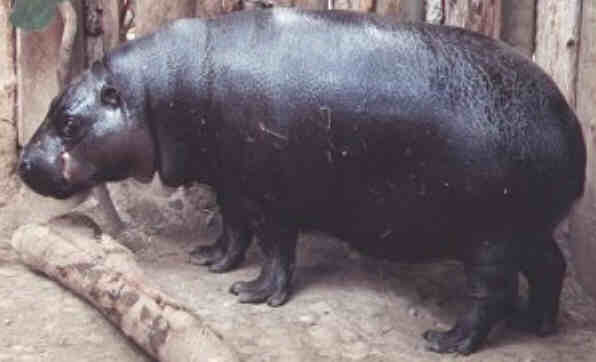 2002
Pygmy hippopotamus is seized by authorities from the Escondido, Califormia,
backyard of Dr. Arthur Stehly, who does not have a permit for the animal,
a 220-kg female about 12 to 15 years old (pygmy hippos can live into their
40s), who has been living in the 2-hectare property for about 10 years,
in company with some 100 other animals, including emus, peacocks, geese,
goats and ducks. The hippo was well cared for except that it did not have
shade nor a pool to immerse itself, so that it suffers from severely dried
and cracked skin with open bloody wounds. There are 2000 to 4000 pygmy hippos
(Hexaprotodon
liberiensis) remaining in the wild, along streams and in wet forests
and swamps in West Africa from Sierra Leone to Nigeria.
2002
Pygmy hippopotamus is seized by authorities from the Escondido, Califormia,
backyard of Dr. Arthur Stehly, who does not have a permit for the animal,
a 220-kg female about 12 to 15 years old (pygmy hippos can live into their
40s), who has been living in the 2-hectare property for about 10 years,
in company with some 100 other animals, including emus, peacocks, geese,
goats and ducks. The hippo was well cared for except that it did not have
shade nor a pool to immerse itself, so that it suffers from severely dried
and cracked skin with open bloody wounds. There are 2000 to 4000 pygmy hippos
(Hexaprotodon
liberiensis) remaining in the wild, along streams and in wet forests
and swamps in West Africa from Sierra Leone to Nigeria. [photo: another individual of the same species >]
2001 In the quake-devastated town of Bhuj, Gujarat, Sikh soldiers pull out from a collapsed eight-story building Kusam D. Soni, in her mid-thirties, alive. She had been pinned down by a ceiling fan for 56 hours.
^ 2001 Five more cardinals.
Pope John Paul II announces more cardinals, adding to the 37 he named on 21 February. They are Lubomyr Husar, US citizen newly appointed Greek rite archbishop of Lviv, Ukraine; Joahannes Joachim Degenhart, archbishop of Paderborn, Germany; Julio Terrazas Sandoval, archbishop of Santa Cruz de la Sierra, Bolivia; Wilfrid Fox Napier, archbishop of Durban, South Africa, and Karl Lehmann, bishop of Mainz, Germany. The pope also reveals two cardinals secretly named in 1998: Marian Jaworski, Latin rite archbishop of Lviv, and Janis Pujats, archbishop of Riga. All 42 new cardinals will assume their rank at the 21 February consistory, bringing to 135 the number of those aged less than 80 and therefore eligible to vote for the next pope.
2000 Elian's hopes to be a US
citizen are dashed.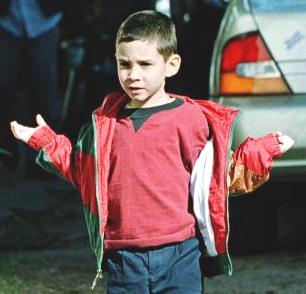 A little boy who lost his mom in a shipwreck and was
lost at sea himself.
A little boy who lost his mom in a shipwreck and was
lost at sea himself. Here he is watching the crowd of reporters and onlookers outside the Miami home of his great-uncle where he is staying. He was expecting to be made a US citizen today, but it did not happen, maybe it never will. He says he wants to stay in the US, but is it just because of the influence of those around him? His father wants him back in Cuba, but did not come to the US to get him, why? Castro, the anti-Castro lobby, and now other politicians too, the Congress, the President of the US, the Pope, the Russian president, and others have been involved or have been asked to be involved. The boy seems to have adapted well to the media and the crowds that observe his every move. But all Elian needs is to be loved. He is loved by his Miami relatives and he is loved by his dad and his grandparents. Cuba and the US should stop fighting over him and see him as a reason to set aside our differences. Why not give him US citizenship AND let his father come and be with him in Miami for a few days and see if he can convince him to go back to Cuba with him? |
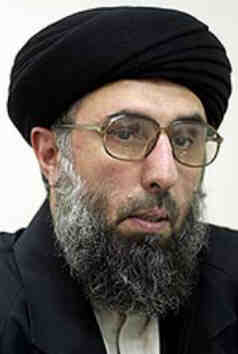 2003 Mohammed Atel Sr., his son Mohammed Atel Jr.,
17, and daughter Sabrin Atel, 15, in the early hours, by
explosion which levels a one-story house in the Sheik Radwan neighborhood
of Gaza, near the seacoast, as two Israeli missile-armed helicopters had
been patroling in the area for two hours. Mohammed Ater Sr. was the bodyguard
of senior Hamas official Ismail Abu Shanab, and the house belonged to Ihab
Salame, another Hamas militant. The AP body count of the al-Aqsa intifada
is now 2071 Palestinians and 720 Israelis.
2003 Mohammed Atel Sr., his son Mohammed Atel Jr.,
17, and daughter Sabrin Atel, 15, in the early hours, by
explosion which levels a one-story house in the Sheik Radwan neighborhood
of Gaza, near the seacoast, as two Israeli missile-armed helicopters had
been patroling in the area for two hours. Mohammed Ater Sr. was the bodyguard
of senior Hamas official Ismail Abu Shanab, and the house belonged to Ihab
Salame, another Hamas militant. The AP body count of the al-Aqsa intifada
is now 2071 Palestinians and 720 Israelis.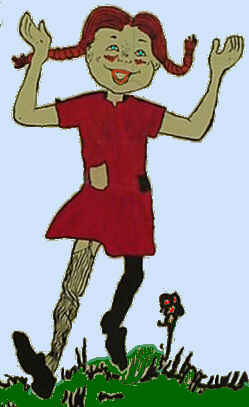 2002
All 9 crew members and 83 passengers, including 7 children, onboard
TAME airlines flight 120, a
2002
All 9 crew members and 83 passengers, including 7 children, onboard
TAME airlines flight 120, a 
